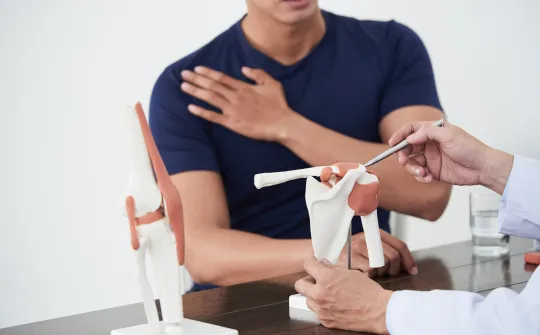
Joint Replacement / Arthroplasty
Tens of thousands of Americans successfully undergo joint replacement procedures every year, helping them find symptom relief and resume the activities they enjoy. With today's advanced surgical techniques and durable joint implant materials, results are long lasting, too.
Our board-certified orthopedic surgeons perform hundreds of joint replacement and joint revision surgeries each year. It's a level of experience that no other orthopedic practice in Maine can match—and it's reflected in our patients' excellent outcomes. Our joint replacement specialists see patients in our Brunswick, Portland, and Windham offices.
When do you need a joint replacement?
- Over-the-counter non-steroidal anti-inflammatory medications (NSAIDS) such as ibuprofen, naproxen and acetaminophen
- Avoiding or modifying activities that cause pain
- Physical therapy and low-impact exercise
- Weight loss to take pressure off damaged joints
- Bracing to provide support Corticosteroid injections
If these conservative measures don't provide sufficient relief, joint replacement may be the best solution for eliminating your pain and restoring mobility. But this decision is made only after a thorough health evaluation and discussion between you and our orthopedic specialists.

Types of Joint Replacement
Minimally invasive knee replacement
Partial knee replacement
Also called a unicompartmental knee replacement, this procedure is an alternative to total knee replacement if your joint disease is limited to just one area of your knee. Your surgeon resurfaces only this portion of your knee with metal and plastic components. A partial knee replacement is less invasive, which often means a faster recovery, and better range of motion and knee function since it preserves healthy tissue and bone in your knee. You are still a candidate for total knee replacement should you need it in the future.
Minimally invasive hip replacement
In traditional hip replacement, the surgeon makes a single, long incision on the side or back of the hip to access the hip joint. Muscles are split or detached from the hip so it can be dislocated and fully viewed. The damaged bone is then cut and removed. With the minimally invasive approach, the surgeon makes one or two shorter incisions, and fewer muscles around the hip are cut or detached. With the minimally invasive approach, there tends to be less soft-tissue damage, a quicker and less painful recovery, and faster return to normal activities. It is not appropriate for everyone, however; the most suitable candidates are thinner, younger, healthier, and motivated to participate in rehabilitation.
Direct anterior hip replacement
This is a minimally invasive surgical technique that involves a 3" to 4" incision on the front (anterior) of the hip. This approach enables the surgeon to access the joint by moving muscles aside along their natural tissue planes, without detaching any tendons. The direct anterior hip replacement procedure often results in quicker recovery, less pain, and more normal function after hip replacement. Patients are able to return to their regular activities shortly after surgery with a reduced risk of dislocation.
Total shoulder replacement
The shoulder is a ball-and-socket joint in which the head of your upper arm bone (humerus) fits into a shallow socket in your shoulder blade. In total shoulder replacement, the damaged parts of the shoulder joint are removed and replaced with a highly polished metal ball attached to a stem, and a plastic socket. Depending on the extent of your joint disease, you surgeon may replace just the head of your humerus bone (ball) or both the ball and the socket.
Total elbow replacement
In this procedure, damaged parts of the humerus (upper arm bone) and ulna (forearm bone on the little finger side) are replaced with an artificial elbow joint made up of a metal and plastic hinge with two metal stems. The stems fit inside the hollow part of the bone called the canal. A partial elbow replacement may also be an option. Your surgeon will talk to you about the best type of elbow replacement for you.
Where Spectrum performs joint replacement surgery
It is also accredited by CMS (Centers for Medicare and Medicaid Services)-certified, which means that the facility meets high standards related to anesthesia, operating and recovery rooms, medical staff, and nursing services in order to be reimbursed by Medicare.

Know what to expect from joint replacement surgery
Studies show that informed patients have better outcomes. There are a number of ways to being informed about your joint replacement procedure. Ask your physician about free joint classes offered by our hospital partners and other educational opportunities to make sure you have all the information you need for your procedure.
An innovative approach to pain management
Rather than rely solely on narcotic medications for pain management after joint replacement, Orthopaedic Associates of Maine takes an innovative multi-modal approach. This means administering two or more drugs that act by different mechanisms to provide pain relief—such as regional nerve blocks and non-narcotic medications.
Research shows that this approach improves pain relief while reducing opioid requirements and their related adverse effects—including the risk of addiction.
Importantly, it enables our patients to be up and moving—without significant pain—within hours of surgery, putting them on a fast path to recovery.
Physical rehabilitation: The key to your recovery
Joint replacement surgery is only the first step in regaining your range of motion, strength, flexibility, endurance, and ability to perform everyday activities. An individualized physical therapy program is essential for your optimal recovery.
You'll begin your physical rehabilitation before your planned procedure and then within hours of waking up from surgery, starting with gentle exercises to help you bear weight and move your new joint. Your Orthopaedic Associates of Maine team will refer you to meet with your therapist before surgery and then you will schedule appointments to be ready for rehabilitation right after discharge.





